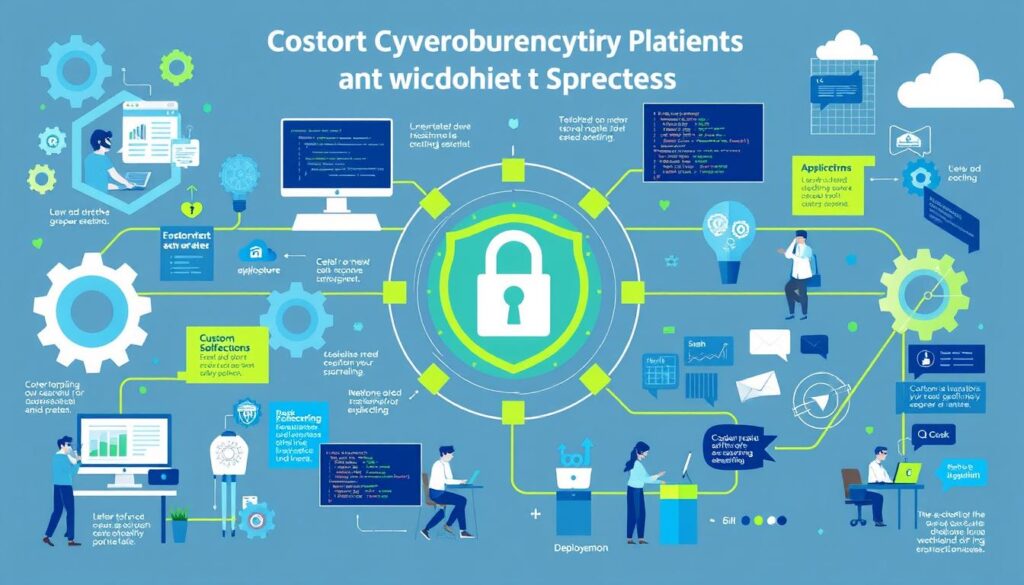In this digital age, the rise of online threats keeps growing. That’s why custom software for cybersecurity solutions is so important. Many organizations worldwide team up with experts in cybersecurity software development. They aim to make tailored cybersecurity solutions that meet their unique needs and goals. With over twenty years of experience, our team uses a wide range of technology and strict security standards. We design personalized cybersecurity software that fits right into your existing systems. Our approach is both immediate and future-oriented, providing protection that evolves to meet new threats.
Key Takeaways
- Proficient in creating custom software for cybersecurity solutions with a 100% Project Completion Rate for over 21 years.
- Provision of 24/7 dedicated monitoring, iterative development, and robust helpdesk support for optimal cybersecurity readiness.
- Extensive technology platforms expertise, including but not limited to React.js, PHP, and Jira, addressing a broad spectrum of software development needs.
- Specialized in cybersecurity, adhering to the highest standards such as IEC 62443 and TISAX® level 3 certification for premiere information security.
- Adoption of advanced methodologies like DevSecOps, ensuring security measures are ingrained throughout the software development lifecycle.
- Custom solutions extend to cloud-based applications, AI, and more, employing contemporary frameworks like .NET and tools like Proxmox.
- Unwavering focus on customer-specific requirements to drive the development of software that’s not just compatible, but also continuously protected and supported post-launch.
Understanding the Need for Custom Cybersecurity Software
Today, the need for personalized software for cybersecurity is clear. Many businesses discover that general security solutions don’t fit their specific needs. They also don’t keep up with the fast pace of new cyber threats. This is why tailored cybersecurity software is so important. It provides a way to defend proactively, designed for specific threats and rules.
The Evolving Threat Landscape
The world of digital threats is always changing. New weak spots and methods of attack come up often. General cybersecurity programs can’t always keep up, which puts organizations at a higher risk of cyber-attacks. Personalized software for cybersecurity lets them react quickly to these dangers. Industries like healthcare, finance, and e-commerce must follow strict rules like GDPR, HIPAA, or PCI DSS. They need security measures that are made just for them.
The attack on Target, where hackers used weaknesses in third-party vendor software, shows why strong, updated custom security is crucial. This breach shows how important it is to protect data with strong custom security measures.
Limitations of Off-the-Shelf Solutions
General cybersecurity products offer basic protection but miss many specific needs of a company. Problems like weak login systems, cross-site scripting, and SQL injection attacks need cybersecurity software customization. Furthermore, these pre-made solutions often don’t support following the rules well. This lack of support can lead to fines and harm a company’s good name.
- Custom solutions can focus on and fix weak settings that general software might not cover.
- Software designed for quick changes can update security fast and reliably.
- Customized training and support, made for the software’s unique setup, improve security.
The need for deep digital security varies greatly between industries, each with their own challenges and rules. This shows cybersecurity software customization isn’t just nice to have; it’s crucial. Choosing to invest in customized cybersecurity solutions offers protection that keeps up with threats. This is not just spending money; it’s about getting a service that lasts and protects well.
Key Features of Effective Cybersecurity Software
In today’s world, keeping sensitive data safe is a big deal. Custom-built cybersecurity software is key to protecting companies from digital dangers. It doesn’t just fight common security threats. It also tackles challenges unique to each business. Let’s look at what makes cybersecurity software really work.
Real-Time Monitoring and Reporting
Real-time monitoring and reporting is crucial in cybersecurity software. It keeps an eye on network activities all the time. It quickly flags any odd activities. This lets businesses quickly deal with threats, reducing harm. Real-time data also aids in making thorough audit trails. This is vital for forensic studies and following laws like GDPR.
Advanced Threat Detection Algorithms
At the core of tailored cybersecurity solutions are smart threat detection algorithms. These tools spot and stop complex cyber dangers, like zero-day attacks, ransomware, and APTs. Using machine learning and AI, they adapt to identify new and changing threats. This keeps security one step ahead of hackers.
User Access Management
Controlling who can see sensitive info is crucial. Effective user access management does this. It helps in reducing the risk of insider threats and meets regulation needs. With custom cybersecurity, businesses can set access controls suited to their risk level and operational needs.

| Feature | Benefits | Relevance to Cybersecurity |
|---|---|---|
| Real-Time Monitoring | Immediate threat detection and response | Essential for maintaining continuous security |
| Advanced Threat Detection | Protects against sophisticated cyber-attacks | Crucial for deflecting modern cybersecurity threats |
| User Access Management | Controls who can access sensitive information | Reduces the risk of data breaches and insider threats |
Having these features in custom-built cybersecurity software improves a business’s security. It also provides a scalable solution that can grow with the company. Using tailored strategies for cybersecurity defense not only secures your business now but also in the future. It protects the company’s reputation and customer trust.
Benefits of Custom Cybersecurity Solutions
In today’s world, digital threats are more advanced than ever. Customized cybersecurity solutions are key to protecting important information. They ensure businesses have strong security measures in place.
Tailored Protection for Unique Business Risks
Each business faces its own set of digital threats. Customized cybersecurity solutions offer protection tailored to these unique risks. They look into each company’s specific dangers and weak spots. Bespoke cybersecurity solutions then adjust security features to fit the business needs and threats.
Improved Compliance with Industry Standards
Industries change, and so do their regulations. Custom cybersecurity solutions help businesses stay up-to-date with these rules. They include necessary controls for each company’s compliance requirements. This helps companies not just meet, but surpass, industry standards. It avoids fines and boosts their reputation in the market.
Enhanced Return on Investment
Custom cybersecurity is a smart long-term investment. It cuts down on the need for extra security tools and lowers operational costs. It also reduces the risk of expensive security breaches. This saves money, ensures business operation continuity, and safeguards revenue.
The growing digital threat landscape makes custom solutions essential. They protect businesses and offer big financial advantages. With such personalized protection and compliance, businesses of all sizes can create a safer environment for everyone involved.
The Development Process of Custom Cybersecurity Software
Creating custom cybersecurity software is a detailed process. It aims to meet a business’s unique security needs. By customizing the development, companies can better defend against various cyber threats. We’ll look into the key steps from start to finish in making cybersecurity software.
Requirements Gathering and Analysis
In the beginning, it’s all about understanding the business’s needs. This step is crucial for identifying current security threats and requirements. Did you know small and medium businesses are hit in 43% of cyberattacks? This highlights the need for strong, bespoke cybersecurity measures. Analysing these needs ensures the software effectively combats such threats.
Design and Architectural Considerations
After understanding the requirements, the focus shifts to the design. In this stage, the plan is to build the software’s framework. This framework must balance security and functionality seamlessly. Teams work together to add strict authentication and encryption, following industry standards to boost user experience.
Testing and Implementation
Before launch, the software is thoroughly tested. This phase helps find any security gaps that hackers could exploit. It often uncovers issues like flawed access controls, which lead to data breaches. Adding layers like multi-factor authentication and thorough quality checks reduces such risks, making the software more secure.
Once testing is complete, it’s time to roll out the software. This requires careful planning for smooth integration into existing systems without disturbing daily operations. Keeping an eye on the system for new threats is critical after implementation.

Cybersecurity goes beyond protecting systems to keeping the business’s reputation and client trust intact. This makes customizing the cybersecurity process vital. Every stage, from initial planning to thorough testing and secure rollout, is key. It helps create software that defends against cyber threats while meeting specific business requirements.
Integrating Custom Software with Existing Security Protocols
The key to cybersecurity software integration is making sure it fits well with current systems. This fit ensures new security features won’t disrupt daily work. Customizing cybersecurity software to match existing protocols strengthens an organization’s safety without causing trouble in operations.
Today, cyber threats change all the time, making security integration very important. An IBM Security study found that a data breach cost $3.86 million on average in 2020. This shows how vital strong cybersecurity is. Custom software can be changed and grown to meet these security needs. By making software that fits precisely, businesses can better protect themselves and save money.
Ensuring Seamless System Compatibility
Adding custom cybersecurity needs careful planning to fit with current IT setups. It’s about choosing tech that offers strong data protection and works smoothly. Experts say investing in the right custom software saves money over time by avoiding breaches and meeting standards.
Training Staff for Effective Use
After putting in new cybersecurity solutions, it’s essential to train workers well. The software should be easy for the team to start using, which reduces downtime and helps productivity. Continued training and support make sure the staff can keep the software and the organization secure.
Spending on cybersecurity is expected to hit $1 trillion from 2017 to 2021, per Cybersecurity Ventures. This shows a growing focus on innovative cybersecurity methods. Custom software helps by making defense stronger and managing security better across services.
| Feature | Benefits |
|---|---|
| Scalability and Flexibility | Allows changes to meet business and tech changes, improving efficiency. |
| Tailored Security Protocols | Makes security better by fitting the software to the business’s specific threats and rules. |
By carefully making and integrating cybersecurity software, companies can protect their digital stuff better. This strategy keeps them safe from losses and puts them ahead in the digital market.
Case Studies: Successful Custom Cybersecurity Implementations
In our digital world, customized cybersecurity solutions are crucial. They help protect organizations in high-risk industries. By looking at cybersecurity software case studies, we see how special tech ensures strong security.
Financial Sector Innovations
The financial sector often faces cyber threats. Yet, it’s making big strides with custom cybersecurity. Cisco’s case study shows a predictive system that cut down attacks. Also, PayPal uses blockchain for safer financial dealings.
Apriorit made an MVP for real-time user action monitoring. It catches suspicious activity well. This solution was key for a client needing a smart yet simple security. This shows the value of custom solutions in tricky situations.
Healthcare Security Solutions
In healthcare, keeping patient data safe is top priority. IBM’s Zero Trust architecture lowered breach risks by only allowing verified access. This keeps patient information safer.
Studies from giants like Google and Samsung offer new ways to stay safe. They use education to fight phishing and AI to better find threats. These steps help a lot.
These cybersecurity software case studies show the strength of specific security solutions. They match the unique needs of each sector. The ongoing tech advancements emphasize how vital and effective customized cybersecurity solutions are.
Challenges in Developing Custom Cybersecurity Software
Creating custom cybersecurity software comes with unique challenges. These include the need for innovation and strict security measures. It’s also important to make the software easy to use. Plus, we must update the software often to protect against new threats.
Balancing Security and Usability
Making cybersecurity software involves a tricky balance. We need to secure sensitive data but keep the software easy for everyone. This means blending strong security with an easy-to-understand design.
Keeping Up with Rapid Technological Changes
Technology and cyber threats change quickly. Our custom software must adapt to new challenges. We do this through regular software updates and planning for future threats.
| Statistical Data | Impact on Custom Software Development |
|---|---|
| 94% of organizations have email security incidents | Increased focus on securing communication channels |
| 71% of organizations have vacant cybersecurity roles | Urgency in training and developing skilled cybersecurity professionals |
| 25% increase in cyber threats from 2021 to 2022 | Frequent software updates and stronger countermeasures needed |
| 71.5% of enterprises rely on threat detection tools | Integrating advanced threat detection technology into custom software |
| Only 20% of businesses avoided cyberattacks in 2022 | Increase in demand for robust, custom-built cybersecurity software |
Having this data shows the big challenges in making effective custom cybersecurity software. But these challenges can be overcome. The solution involves continuous learning and applying strong security measures. Doing this makes it possible to create software that is safe and easy to use.
Future Trends in Custom Cybersecurity Software
The world of digital security is always changing. Soon, cybersecurity software will use new tech to protect us better. As companies want stronger safety tools, AI’s role in fighting cyber threats is growing. By 2025, about 85% of businesses will use AI. This means our systems will not just react to threats but can prevent them early on.
AI and Machine Learning Applications
Soon, the market for AI in cybersecurity will jump from USD 22.4 Billion in 2023 to USD 60.6 Billion by 2028. That’s a huge increase! AI and machine learning will make threat detection much better. With the power to analyze big data, these systems will quickly recognize and stop new threats.
Also, with edge computing possibly reaching USD 156.6 billion by 2030, AI will work with it for smarter, spread-out threat prevention.
The Rise of Automation and Incident Response
Automation in responding to cyber threats is becoming key for secure systems. It helps organizations react faster, cutting down response time by up to a day. It also lessens human mistakes. The push for faster, automatic responses is huge. The market for serverless computing is expected to grow to $36.8 billion by 2028.
Additionally, combining 5G and edge computing will create even faster, more efficient cybersecurity responses. This blend might generate over USD 10 billion by 2027.



